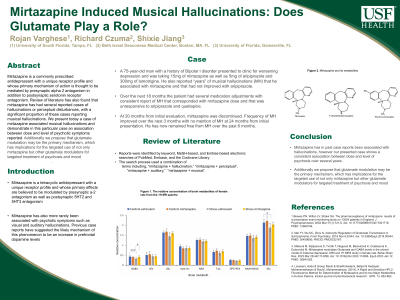Psychopharmacology and Toxicology
Session: Poster Session
(147) Mirtazapine Induced Musical Hallucinations: Does Glutamate Play a Role?

Trainee Involvement: Yes
- RV
Rojan Varghese, MD
Resident Physician
University of South Florida
Tampa, Florida, United States - RC
Richard Czuma, MD
Sleep Medicine Fellow
Beth Israel Deaconess Medical Center
Boston, Massachusetts, United States 
Shixie Jiang, MD
Assistant Professor
University of Florida
Gainesville, Florida, United States
Presenting Author(s)
Co-Author(s)
Mirtazapine is a tetracyclic antidepressant with a unique receptor profile and whose primary effects are believed to be modulated by presynaptic a-2 antagonism as well as postsynaptic 5HT2 and 5HT3 antagonism. Mirtazapine has also more rarely been associated with psychotic symptoms such as visual and auditory hallucinations (Biswas, 2003). Previous case reports have suggested the likely mechanism of this phenomenon to be an increase in prefrontal dopamine levels. However, in this report we describe a case of mirtazapine induced hallucination but propose that this and similar cases may be more indicative of the role of mirtazapine in glutamate modulation. Clinicians need to be aware of this mechanism of action when considering targeted therapy of mood and psychotic symptoms in the inpatient setting. A 75-year-old man with a history of Bipolar I disorder presented to clinic for worsening depression and was taking 15mg of mirtazapine as well as 5mg of aripiprazole and 300mg of lamotrigine. He also reported “years” of musical hallucinations (MH) that he associated with Mirtazapine and that had not improved with aripiprazole. Over the next 18 months the patient had several medication adjustments with consistent report of MH that corresponded with mirtazapine dose and that was unresponsive to aripiprazole and quetiapine. At 20 months from initial evaluation, mirtazapine was discontinued. Frequency of MH improved over the next 3 months with no mention of MH at 24 months from initial presentation. He has now remained free from MH over the past 6 months. This case suggests a causal relationship between mirtazapine and psychotic symptoms in a patient observed over the course of several years. The glutamate hypothesis of schizophrenia proposes that psychotic symptoms are at least in part due to excessive release of glutamate in areas of the brain such as the prefrontal cortex and hippocampus(Mei, 2018). Additionally, depression studies have demonstrated that mirtazapine treatment is associated with maintenance of glutamate levels and preserved volume in the prefrontal cortex and hippocampus, possibly a mechanism by which its antidepressant effect is mediated. Mirtazapine has in past case reports been associated with hallucinations, however our presented case shows a consistent association between dose and level of psychosis over several years. Additionally we propose that glutamate modulation may be the primary mechanism, which has implications for the targeted use of not only mirtazapine but other glutamate modulators for targeted treatment of psychosis and mood. Biswas PN, Wilton LV, Shakir SA. The pharmacovigilance of mirtazapine: results of a prescription event monitoring study on 13554 patients in England. J Psychopharmacol. 2003 Mar;17(1):121-6. doi: 10.1177/0269881103017001716. PMID: 12680749. Mei YY, Wu DC, Zhou N. Astrocytic Regulation of Glutamate Transmission in Schizophrenia. Front Psychiatry. 2018 Nov 6;9:544. doi: 10.3389/fpsyt.2018.00544. PMID: 30459650; PMCID: PMC6232167. Maková M, Kašparová S, Tvrdík T, Noguera M, Belovičová K, Csatlosová K, Dubovický M. Mirtazapine modulates Glutamate and GABA levels in the animal model of maternal depression. MRI and 1H MRS study in female rats. Behav Brain Res. 2023 Mar 28;442:114296. doi: 10.1016/j.bbr.2023.114296. Epub 2023 Jan 12. PMID: 36641082.
Background:
Case:
Discussion:
Conclusion:
References:

